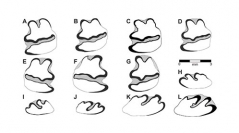

 Comptes Rendus Palevol
14 (5) - Pages 371-385
Comptes Rendus Palevol
14 (5) - Pages 371-385Plio-Pleistocene climate oscillations in the different regions of Western Europe substantially influenced the evolutionary history of European leporids. Distinguishing rabbits (Oryctolagus) from hares (Lepus) in the archeological and palaeontological record of Pleistocene Europe is complicated due to the variability of their size and morphology. Here, we present the first description of two Pleistocene leporid species from Bois-de-Riquet (Lézignan-la-Cèbe, Hérault) in southern France. The first, Oryctolagus cf. giberti, exhibits similar characteristics to rabbit species documented in Spain and, thus, for the first time is recorded outside the Iberian Peninsula. The second leporid is a hare represented by very limited number of non-diagnostic remains, which, unfortunately, precludes an exact species identification. Already known from Lower Pleistocene deposits in Central Europe and Spain, the presence of Lepus sp. in southern France sheds new light on the geographic extension of these species. In this respect, Bois-de-Riquet is an important paleontological site that can further our understanding of the evolutionary history and expansion of European leporids.
Evolution, Biochronology, Systematic, Oryctolagus cf. giberti, Lepus sp., 2D geometric morphometry